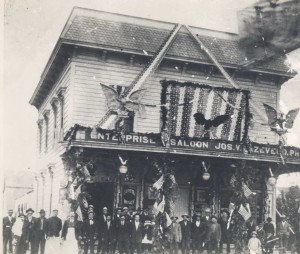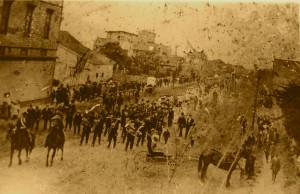[I wrote this story in 1977.]
July 4th Celebration at Half Moon Bay in the 1890s
All day long a steady stream of visitors poured into Half Moon Bay, many of them from as far away as San Francisco. By noon the line of horse and buggies parked along Main Street looked more like a crowded city scene than a quiet country town.
One of the local papers, probably the Coastside Advocate, estimated that at least 300 strangers joined the local citizens to celebrate one of the biggest Fourth of July’s anybody could remember.
The townsfolk started getting ready for the big party, the 114th anniversary of American Independence, as early as the day before. Everybody pitched in to decorate, draping red, white and blue bunting and streamers over businesses and private homes.
Not only the American flag but a display of banners from all over the world produced an instant flash of color. Flags floated out of all but a very few homes–and overnight, Half Moon Bay struck the appropriate patriotic look.
Promptly at sunrise, and it was going to be a sunny day, the early pioneer W.A. Simmons fired the town’s five pound cannon and led the national salute. And then droves of people from the city and the surrounding countryside arrived, all in a festive mood.
Young and old, dressed- up for the occasion, thronging the streets as firecrackers popped profusely in the background.
Of course, getting to this point wasn’t as smooth as it looked. There had been disagreements within the citizen’s committee responsible for the Fourth of July events. It got so bad that the celebration came within an inch of being canceled. But in the end, all ruptures were healed, all differences settled amicably. All worth it, too–because the carriages were rolling in, their horses prancing, and the children, always adorable, shouted and played in the street.
The noise of the crowd settled down to a muffle and heads turned to watch the ceremonial unfurling of flags over the “business houses.” Everybody who owned a building dressed up theirs for the Fourth including Levy Bros, R.I, Knapp’s Plow Factory, William Pringle’s Shop and Boitano Bros. Mercantile.
At 10 am sharp, the honorary “president of the day” led the PARADE, a grand civic procession that began at Schuyler’s Hotel and marched down Kelly, with the Half Moon Bay Cornet Band playing Francis Scott Key’s Star Spangled Banner. Trailing behind the band was a lovely Fourth of July float, drawn by a team of fine local horses.
A group of children scrambled to catch up with the parade, as the older folk strolled along. At Main Street, the colorful parade turned south toward Miramontes Street–and the entire procession stopped outside the grammar school.
There, in the shade of large cedar trees, stood a recently constructed pavilion, decorated with thick bunting and flags. Behind the pavilion, and near the bandstand, stood an elevated stage, featuring a set of “roll curtains” for the anxiously awaited “tableaux.”
As the master of ceremonies introduced the lengthy literary program to a sea of faces seated beneath him, the cornet band (this was their third gig) struck up Our Flag is There followed by Red, White and Blue, sung off-key by the little kids.
School officials raised the flag as a wave of applause rippled through the crowd.
But everybody was there for the long-awaited, much-discussed tableaux, (A tableaux is a dramatic activity where a group of students are asked to physically construct a significant scene from literature through body placement, facial expressions, and the use of a few props.) This one was called Colonial Times, and the nervous actors assembled on the elevated stage where they could look down into the audience and see the smiling faces of friends and family.
Colonial Times featured thirteen girls representing the original colonies, all dressed alike in white costumes with a broad sash bearing the name of the state. As the curtain raised on this patriotic scene (where Liberty, Army, George and Lady Washington froze in a symbolic pose) a hushed silence swept through the audience. A few minutes later it was was all over as the band struck up a patriotic number and the curtain lowered on the characters who managed to remain perfectly still the entire time.
The stage was also reserved for a series of recitations, one a stirring piece called Independence Day, another entitled E Pluribus Unum. Midway through the spirited program, the Rev. B.F. Taylor delivered an uplifting address. And, as the audience loudly sang America in unison with the actors gathered on stage, the curtain slowly dropped to thunderous applause.
In the evening some 150 people crowded into the Pacific Hall for a night of dancing, where the popular string band, the Melville Brothers entertained. Around midnight, the ladies’ Fourth of July committee served a special supper at the Ocean Shore Hotel. The party wasn’t over until dawn when the band finally went home.
There were no glitches in that smooth-running Fourth of July celebration–but now I’ll tell you about the one that had a hard time getting off the ground. It happened the very next year.
From the beginning an unexpected death and funeral threw the official Fourth of July Committee’s plans into chaos as well as casting gloom over everyone.
The Cornet Band was over four hours late. The literary event was cut short. Songs were canceled. There was a rushed performance by the schoolchildren, a hastily read Declaration of Independence, and that was the gist of the live performance.
The day’s organizers found themselves constantly apologizing for the poorly put together event to no avail–even the afternoon barbecue failed to attract a hungry crowd.
Things were looking pretty bad; there were fears that this Fourth of July would go down in the record books as one of the worst when there was a decided turn in luck. As time for the horse races drew near, excitement infected the spectators who watched the trotting races– open to Coastside horses only–the buggy races and the half-mile running races.
The locals loved cheering on their local youth in the foot races. Joe Quinlan sprinted 100 yards to win a silk negligee shirt. There were contests for married men only and an unscheduled event: the race between Lawrence’s milch cow and Donovan’s cart mule (the cow came in second).
By nightfall, over 200 guests assembled at the Pacific Hall for dancing. The Fourth of July Ladies Committee served a memorable supper–and Half Moon Bay rested on her laurels for pulling off another successful Fourth of July, after all.
(Main Street, Half Moon Bay)


